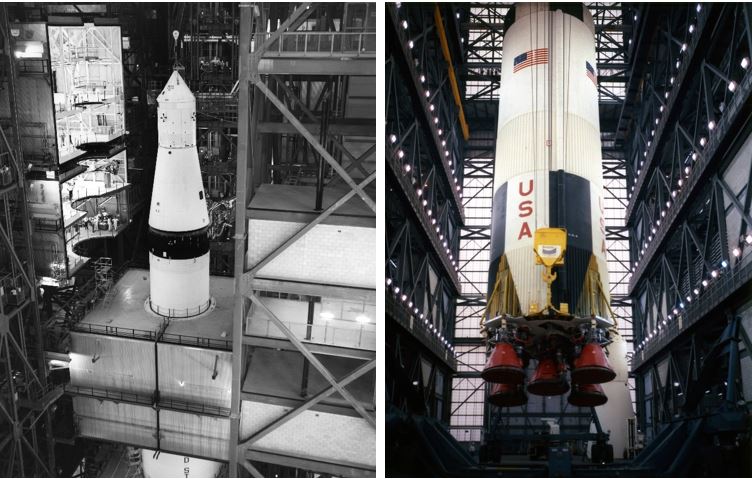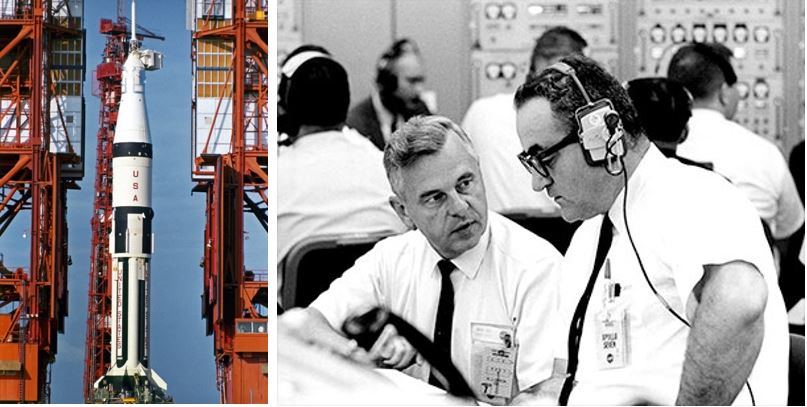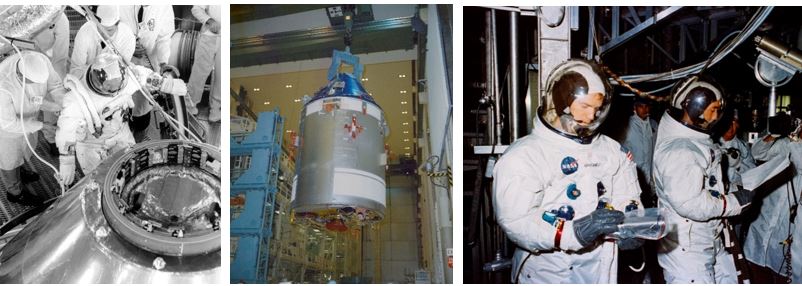With launch just two weeks away, the Apollo 7 spacecraft and its Saturn IB rocket passed the last major test before flight. The Agency was also preparing for the next two missions, using the larger Saturn V rocket to carry astronauts into space. Apollo 8, scheduled for December 1968, was at this time planned as an Earth orbital test of the Saturn V with the Command and Service Modules (CSM), but NASA was considering other options for the mission, including a circumlunar flight. Apollo 9 was planned for early 1969 to be the first crewed flight of a Lunar Module (LM), in an Earth orbit test of all three principal Apollo spacecraft components.
NASA began the Flight Readiness Test (FRT), the final systems verification of the Apollo 7 spacecraft and its Saturn IB rocket before the launch countdown, at Kennedy Space Center (KSC) September 25, 1968. The FRT tied in controllers at Mission Control at the Manned Spacecraft Center, now the Johnson Space Center, in Houston, with the launch team in the Firing Room in the Blockhouse at Launch Complex 34. The test included simulated countdown events and mission simulations, and the team exercised various abort scenarios. Apollo 7 crewmembers Walter M. Schirra, R. Walter Cunningham, and Donn F. Eisele participated in various portions of the FRT. For this exercise, the crew did not wear their spacesuits and the spacecraft hatch remained open. The FRT concluded on September 27, having met all objectives.
The U.S. Navy was preparing for its role in the Apollo 7 mission as well. The Navy designated the aircraft carrier USS Essex as the prime recovery ship for this flight, but to prepare for any possible emergency landings, the Navy deployed about 10,000 personnel, 12 ships and 50 aircraft. The Essex positioned herself about 400 miles east of Cape Canaveral for the launch, and then relocated to the prime splashdown zone about 200 miles southwest of Bermuda.
Preparations for the next two missions were well underway. At KSC’s Manned Spacecraft Operations Building (MSOB), Apollo 8 prime and backup crewmembers completed altitude chamber tests of their spacecraft. On September 20, prime crew of Frank Borman, James A. Lovell, and William A. Anders, donned their spacesuits and climbed inside the Command Module (CM) for the exercise. Two days later, backup crew of Neil A. Armstrong, Edwin E. “Buzz” Aldrin, and Fred W. Haise, repeated the test. Also in the MSOB, astronauts assigned to the Apollo 9 mission completed the first crewed altitude
chamber tests of their Lunar Module (LM). Prime crewmembers James A. McDivitt and Russell L. “Rusty” Schweickart completed two chamber runs as did their backups Charles “Pete” Conrad and Alan L. Bean. The tests, completed September 27, met all planned objectives.
In the Vehicle Assembly Building (VAB), workers had already stacked the three stages of the Saturn V for Apollo 8 on its Mobile Launch Platform (MLP). Engineers successfully completed a test of the assembled rocket, and also tested the swing arm the crew would use to enter their spacecraft. For that test, workers temporarily stacked a boilerplate Apollo spacecraft on the rocket. Rollover from the MSOB of the CSM and the Spacecraft LM Assembly
containing the LM Test Article-B (LTA-B), a boilerplate to simulate the mass of an actual LM, was planned for early October, with stacking to the rocket and subsequent rollout to Launch Complex 39A a few days later. By late September, all three stages of the Apollo 9 Saturn V had arrived in the VAB, awaiting stacking on another MLP in early October.

crew would use to access their spacecraft (left). The first stage of the Saturn V for the Apollo 9 mission begins the first steps of the
assembly process (right).
Although NASA and contractor employees were wholly immersed in the goal to land a man on the Moon before the end of the decade, some may have turned on their televisions on the evening of September 24, 1968, to watch the premiere of a new program called 60 Minutes. Hosted by Harry Reasoner and Mike Wallace, 60 Minutes began as a bi-weekly television news magazine program on the CBS Network, initially airing Tuesday evenings. The segments on the inaugural episode included: a look at presidential candidates’ suites at their respective nominating conventions; commentaries on the American electoral system by several European writers; a commentary by political columnist Art Buchwald; an interview with Attorney General Ramsey Clark about police brutality; a brief scripted piece about the presidential campaign; an edited version of an Academy-Award winning short film; and a meditation by Wallace and Reasoner on the relation between perception and reality, with Wallace endorsing the show’s realism.

























